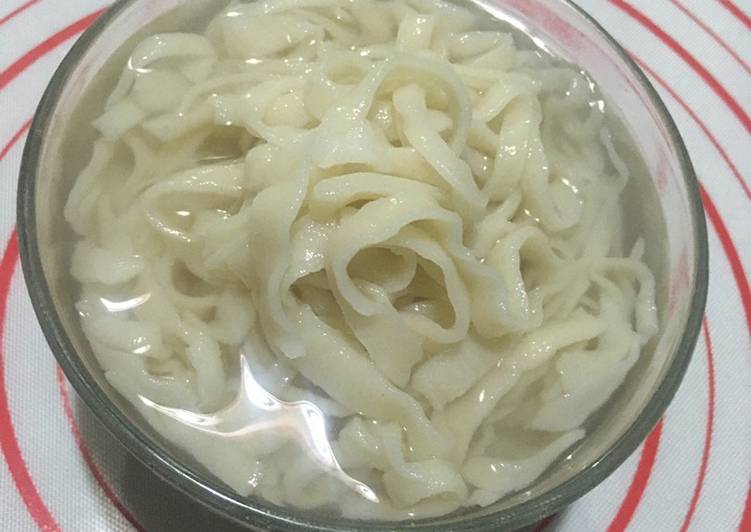Sharing on how to made Japanese Ramen noodle, is very easy , just flour, water, egg white and alkaline water and your hand Everyone can done it at home. Making good ramen noodles at home is a simple process, so long as you have a few key ingredients. These noodles are meant for use in shoyu ramen and miso tori paitan, and are best paired with relatively light-bodied broths, though they can feasibly be used with most any ramen recipe.
 So tired of buying the dried up I love making fresh pasta and I love the idea of making fresh ramen, especially considering that.
Traditional Japanese Homemade Udon Noodles Recipe!
Let me show you how to make your own udon noodles from scratch and use them for your Udon noodles are one of the most traditional Japanese noodles, which can be used in ramen or stir-fry.
Bunda bisa buat Homemade fresh ramen noodle / udon ala fe
(mi ramen homemade) memakai 4 bahan dan 4 langkah. Begini cara membuatnya.
So tired of buying the dried up I love making fresh pasta and I love the idea of making fresh ramen, especially considering that.
Traditional Japanese Homemade Udon Noodles Recipe!
Let me show you how to make your own udon noodles from scratch and use them for your Udon noodles are one of the most traditional Japanese noodles, which can be used in ramen or stir-fry.
Bunda bisa buat Homemade fresh ramen noodle / udon ala fe
(mi ramen homemade) memakai 4 bahan dan 4 langkah. Begini cara membuatnya.
Bahan-bahan buat Homemade fresh ramen noodle / udon ala fe (mi ramen homemade)
- Siapkan 150 gr tepung terigu protein tinggi.
- Anda butuh 15 gr tepung tapioka.
- Anda butuh 1/4 sdt garam.
- Siapkan 125 ml air hangat.
I love making this Udon Stir Fry Recipe. Our easy to make recipe for Homemade Ramen Noodles will have you eating Ramen in no time. Using your KitchenAid mixer and pasta attachments That one rainy weekend we had back in January we decided it was a good time to stay in and make ramen. We wanted a big bubbly pot of broth to. How to make homemade ramen noodles from scratch. How to make homemade ramen noodles from scratch.
Cara memasak Homemade fresh ramen noodle / udon ala fe (mi ramen homemade)
- Siapkan semua bahan & timbang. Ayak terigu & tepung tapioka dalam 1 bowl. Tambahkan garam. Aduk rata. Tuang air hangat sesendok sesendok sambil aduk adonan tepung hingga berbutir & basah. Setelah semakin besar gumpalan adonan, mulai uleni dengan tangan hingga kalis. Kira2 sekitar 5 - 10 menit. Adonan memang agak kering ga se-moist adonan kulit dimsum gyoza yg ada diresep sebelumnya. Tapi nanti akan lembut dengan sendirinya setelah diistirahatkan..
- Setelah kalis, balur tepung ke adonan & wadah untuk meletakkan adonan, bungkus plastick wrap & lap/handuk lalu istirahatkan 30 menit - 1 jam. Masukkan adonan kedalam plastik tebal. Ikat. Bungkus dengan kain lebar/ handuk bersih. Injak2 dengan kaki yang sudah dicuci bersih. Setelah pipih lipat 4 sisi lalu bungkus plastik lagi. Ulangi 3x. Klo plastik sobek musti diganti baru. Setelah kalis, bungkus plastik & tutup lap/handuk. Resting/ diamkan 3-6 jam..
- Setelah 3 jam lebih keluarkan adonan dari plastik. Taburi silmat dengan terigu agar adonan tak lengket. Gilas adonan hingga pipih. Untuk yg punya mesin giling mie bisa mulai giling adonan dari ukuran terbesar dulu lalu turunkan ke ukuran lebih kecil, 5,4,3. Lalu setelah adonan halus elastis mulai dicetak mie. Jika manual, iris sesuai selera. Unt mie ramen biasanya kurang dari 2mm untuk udon sekitar 4mm. Selalu taburi tepung agar tidak lengket satu sama lain..
- Rebus sebentar saja sambil aduk2 untuk melarutkan lapisan tepungnya. Angkat tiriskan langsung masuk ke air es. Siap diolah..
These firm yellow Chinese style noodles are made with flour, kansui and water. So, by now I think you're discovering that making ramen from scratch is a pretty intensive process. Even though Tsuji called for dried udon in his recipes, he repeated told the reader that homemade is better.
Then he quietly provided an udon noodle recipe. Homemade Ramen Noodles are something that any real ramen fan needs to make at least a few times in their life. While it isn't a fast element of the That's all to say, I didn't invent any wheels here, and you don't have to either. I am pretty happy with my version of the traditional homemade ramen.
Gampang sekali kan buat Homemade fresh ramen noodle / udon ala fe (mi ramen homemade) ini? Selamat mencoba.